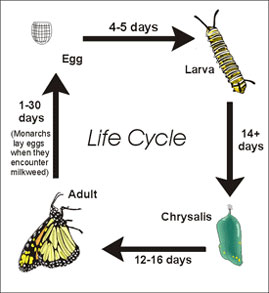
An illustrated diagram is also included to show the cyclical nature of the caterpillar to butterfly processThis information PowerPoint will support your teaching on The Cautious Caterpillar available as an eBook. With all this eating a caterpillar grows quickly.
To keep up with the growth its body has to adapt.
How long is a caterpillar life cycle. When working with caterpillars it is important to understand their lifecycle. A caterpillar is a wormlike and often brightly colored or hairy or spiny larva of a butterfly or moth. It is nearly impossible to tell whether a caterpillar will turn into a moth or a butterfly without identifying the species of caterpillar.
Dyer has been working for over 15 years collecting caterpillars and rearing them to determine what. When the caterpillars are full grown after about 2 months of eating leaves they find a place to hide and transform into the pupal stage. The picture on the right shows a.
The caterpillar has very limited and poor sight. When the Woolly Bear caterpillar has consumed enough food and is ready to change into a moth it will form a chrysalis over his body and stay there for three to four weeks before emerging as a moth and completing the life cycle. With all this eating a caterpillar grows quickly.
In 7 to 17 days its weight increases 2700 times. If humans grew that quickly wed be as tall as the Statue of Liberty in just 2 weeks. To keep up with the growth its body has to adapt.
The pupation stage lasts approximately 10 to 14 days. During this period the caterpillars transform into adult moths and emerge from the cocoon. Male and female cocoons.
The entire larval stage is about 2-3 weeks depending on the weather and food availability If you miss the chance to collect them as eggs then just look for the caterpillars. When the eggs hatch the caterpillars will stay together in groups feeding on the favorite host plants Willow Aspen and Cottonwood until they are close to pupating. The life cycle of the butterfly is made up of four stages.
The first three stages last between 30 and 120 days this will depend on both the species and the environmental conditions. Lets dive deeper into the characteristics of each stage of the butterfly life cycle. The caterpillar is the larval stage in the butterfly life cycle.
After the egg hatches it may start its eating binge by eating the shell of the egg from which it hatched. Most butterfly larva will eat the host plant its egg was laid on. Some eat flower buds seeds or roots.
Recognized among the largest in North America they have a wingspan of up to 4 ½ inches with a lifespan of just 7 days. So they have as little as a week to do as much as they can including reproducing before they finally perish. Use this simple caterpillar to butterfly PowerPoint to explain the caterpillar and butterfly life cycleThe slides feature helpful real-life images of each stage.
Egg caterpillar chrysalis butterfly. An illustrated diagram is also included to show the cyclical nature of the caterpillar to butterfly processThis information PowerPoint will support your teaching on The Cautious Caterpillar available as an eBook. Caterpillars grow rapidly and typically complete their larval development in seven to eight weeks.
When fully grown the caterpillars leave the natal tree and seek protected places on the ground or under the eaves of buildings to spin their cocoons. About two weeks later they emerge as adults. The caterpillars for example eat a lot whereas adults reproduce.
Depending on the butterfly species these stages last from several weeks to a year. By the fourth instar the monarch caterpillar is between 13 and 25 mm in length. The front tentacles are now 5mm in length while those at the back are around 2 mm in length.
White spots on the caterpillars prolegs the 5 pairs of false legs at the rear of the larvas body are more easily visible. This stage lasts from 1 to 3 days. Caterpillars have soft bodies that can grow rapidly between moults.
Their size varies between species and instars moults from as small as 1 millimetre 0039 in up to 14 centimetres 55 in. Some larvae of the order Hymenoptera ants bees and wasps can appear like the caterpillars of the Lepidoptera. Such larvae are mainly seen in the sawfly suborder.
To grow into an adult they go through 4 stages. Egg larva pupa and adult. Each stage has a different goal - for instance caterpillars need to eat a lot and adults need to reproduce.
Depending on the type of butterfly the life cycle of a butterfly may take anywhere from one month to a whole year.